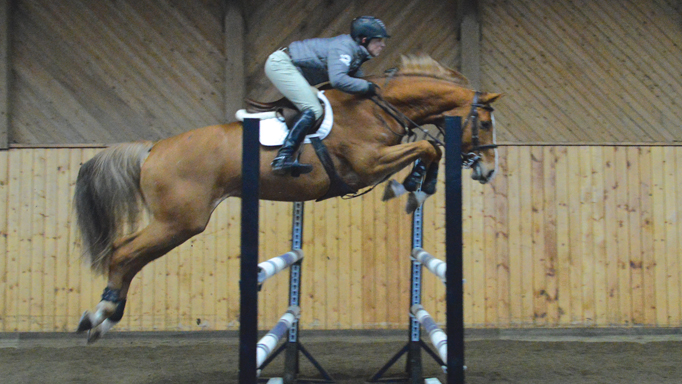I don’t teach people to find the distance, or even to look for the distance. I teach a system that will consistently yield a good jump. Some people are certainly gifted in the respect that they always know how far away from the jump they are, but there are reasons you see a distance, and the key is to make those reasons happen consistently.
I don’t even like to use the word ‘distance,’ because it is so ingrained and associated with ‘looking’ and ‘finding.’ It’s much easier to just teach people to develop the underlying structure that needs to be applied to each ride. We are not trying to find the ‘takeoff spot’ on the ground; we are trying to get the best possible jump we can from the horse, regardless of the distance from the jump that they leave the ground. Each individual horse is going achieve their best jumping effort from a different takeoff spot, and it’s about consistently creating a ride that allows the horse to arrive at that optimal placement.
Back to basics
To get a good jumping effort, horses need energy, rhythm, straightness, and balance; those are the four cornerstones of good riding. If you can produce all of that in your flatwork, then you’ve given the horse the ability to jump well from virtually every distance before we even talk about the jump.
The key is creating a really good-quality canter. So many people believe it’s about the stuff they do over fences, but when I have riders with anxiety about distances, we take it way back to the canter. If you build the proper structure on the approach, you will feel the horse lock-in on their optimum distance and carry you to the jump. That’s where I believe the expression of ‘seeing the distance’ comes from. It’s not magic, and it’s certainly not the ability to tell how far away you are.
When you drive a car, if you step on the gas, the car accelerates the exact same way. Steering and brakes are the same. That’s basically what you’re trying to create when you’re training a horse. You are trying to create one that responds in the same way each time. If you build a square corner and find a straight approach while carrying a decent amount of energy and keeping a rhythm, you will get a good jump. It’s like building blocks, and this sport above all others will come back to bite you if you skimp on the foundation. Energy, rhythm, straightness, balance – if we can make them all stay in equal measures all the time, the canter stays the same and you will arrive at the jump right where you want to be.
A consistent approach, literally
Once you establish a structure on the approach to the fence, the goal becomes to create that same approach every time – to build a regularity to the canter, then build a structured turn. If you can do that, the horse will lock in on the target and start to see where he is on the way to the jumps, and in turn help compensate for being a bit deep or a bit long on his own. Then, because we’ve removed all the anxiety, the rider can just focus on ‘seeing’ where they are, because the canter is the same, because the turn is the same, and because the approach is the same every time.
Once the rider becomes familiar with it, and the horse begins to learn from this consistency, all of the jumps will be consistently good. Without that structure, riders will continue to approach randomly, which will produce random results, and they will never develop an eye.
As you progress as a rider, in advanced flatwork you can create different shapes with the horse. For example, the shape between a jumper and a hunter differ, but once you develop the canter you want, you can create the jump you want. The underlying structure should be practiced in a full seat, in a half seat, and basically every position you are going to utilize, because the aids should work the same in every position.
Finding the best distance in the world isn’t going to help you if you arrive with an inappropriate amount of energy to jump, or with a horse out of balance. Without straightness, balance, energy, and rhythm, you are going to see refusals, weak take-offs, and horses jumping in poor form.
Finding the distance is not the most important thing; it’s about building the best jump. If we can consistently present this structure to horses so that they can understand it, they become able to help us create that good jump.

